
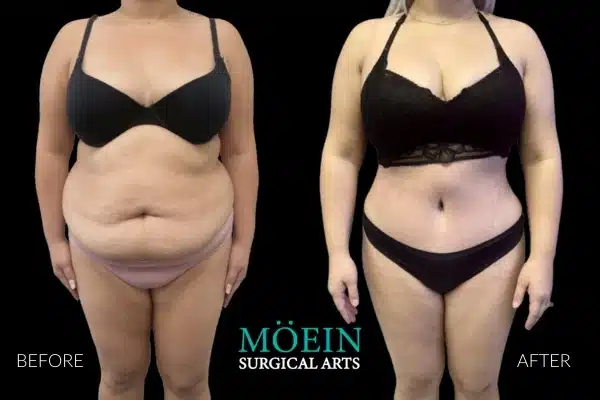
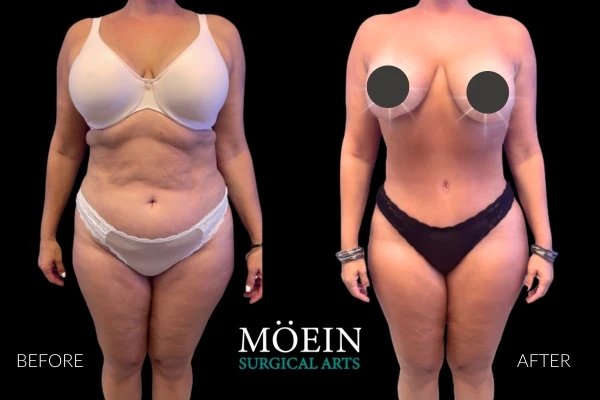
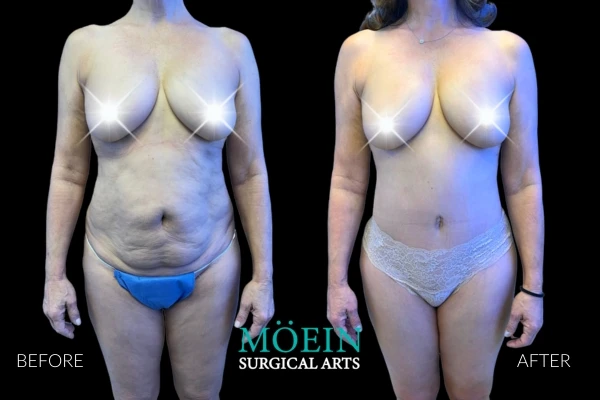
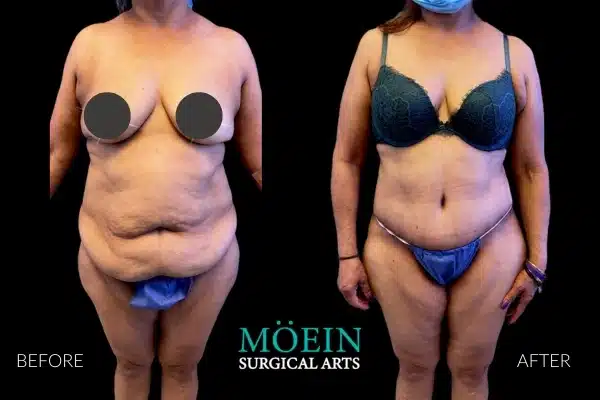
Flank liposuction, a most effective means of shaping the waistline area and getting rid of those ‘love handles ’, has remained one of the leading cosmetic procedures available in Los Angeles. The ‘Before and After’ gallery on this page features actual patients who achieved a slimmer, more contoured figure with cosmetic surgeon Dr. Moein and VASER-assisted liposuction.
These results emphasize the importance of fat extraction in the flanks in shaping the waistline and enhancing one’s proportion and overall figure. Every case illustrates the accuracy, safety, and artistry with which Moein Surgical Arts performs the procedure of flank liposuction.
For many individuals, the flanks are among the most resistant areas of fat, often being unaffected despite exercise, diet, and weight loss. A liposuction procedure on the sides provides a very effective way to selectively reduce fat by creating a few entry points, so the waistline can look slimmer, smoother, and narrower. VASER-assisted liposuction is even more precise, enhancing sculpting and reducing recovery time.
The ‘Before and After cosmetic surgery‘ pictures on this page feature a series of patients of different ages and physiques, which better illustrate how individualized flank liposuction can be. A person may seek only a slight change in the definition of the waistline, whereas others may seek a much more dramatic alteration; these cases clearly convey just what can be accomplished with the highest order of results. These outcomes reflect Dr. Moein’s expertise and his commitment to delivering natural, balanced, long-lasting improvement.
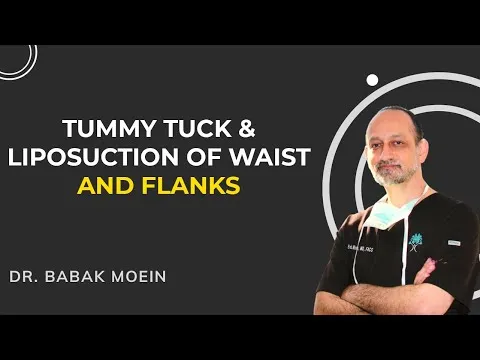
Patients suitable for both upper and lower flank liposuction are those who lead healthy lives but find it difficult to eliminate fat in the upper pelvis, such as the “love handles” or “muffin tops” when viewed from the back. These are fat deposits that are not affected by healthy eating or exercise, which is why liposuction is needed.
Patients looking to refine their figure with a more defined waist or a snatched, hourglass figure can have both procedures combined to help the flanks through fat reduction via liposuction. Patients looking for a dramatic change in the waist area can learn more in our other guides, such as how to get a snatched waist in Los Angeles.
In addition, the results of liposuction can serve as motivation to maintain a healthy diet and exercise routine. Knowing that the investment they made in their bodies can be further enhanced by maintaining a healthy lifestyle can be a powerful incentive for candidates. Overall, ideal candidates are those with realistic expectations, stable weight, and a desire to refine the waistline through precise surgical contouring.
The quantity of fat that can potentially be aspirated in flank liposuction can vary from patient to patient, depending on the overall size and physical well-being of the individual. In most cases, there needs to be an appropriate limitation outlined in terms of safety, up to 5 liters of aspiration. However, the quantity can vary based on individual considerations in the course of surgery.
In the process, Dr. Moein considers numerous factors, such as BMI, skin quality, and fat distribution, to determine how much fat can be safely and effectively removed. It is essential to consider that removing excessive fat increases the risk of complications, such as fluid shifts or irregularities in fat distribution.
When patients compare treatment alternatives or plan their finances, our comprehensive resource, “Liposuction Cost in Los Angeles,” helps you understand the factors that contribute to cost, so you can understand what impacts your financial outlay.

Liposuction is a body-contouring procedure designed to remove stubborn fat that does not respond to diet or exercise. During the surgery, a thin tube called a cannula is inserted through small incisions to precisely suction out fat and sculpt the treated area. Modern techniques, such as VASER ultrasound-assisted liposuction, allow for greater precision, smoother results, and reduced trauma compared to older methods.
Liposuction is not intended for weight loss. Instead, it is most effective for patients who are near their ideal body weight but have localized fat deposits in areas such as the flanks, abdomen, thighs, arms, or neck. Ideal candidates maintain good overall health, have realistic expectations, and are seeking improved contour rather than large-volume fat removal.
When performed safely, liposuction offers long-lasting improvements in body shape, enhanced proportions, and increased confidence. Results can be maintained long-term with a stable weight, healthy nutrition, and regular physical activity.
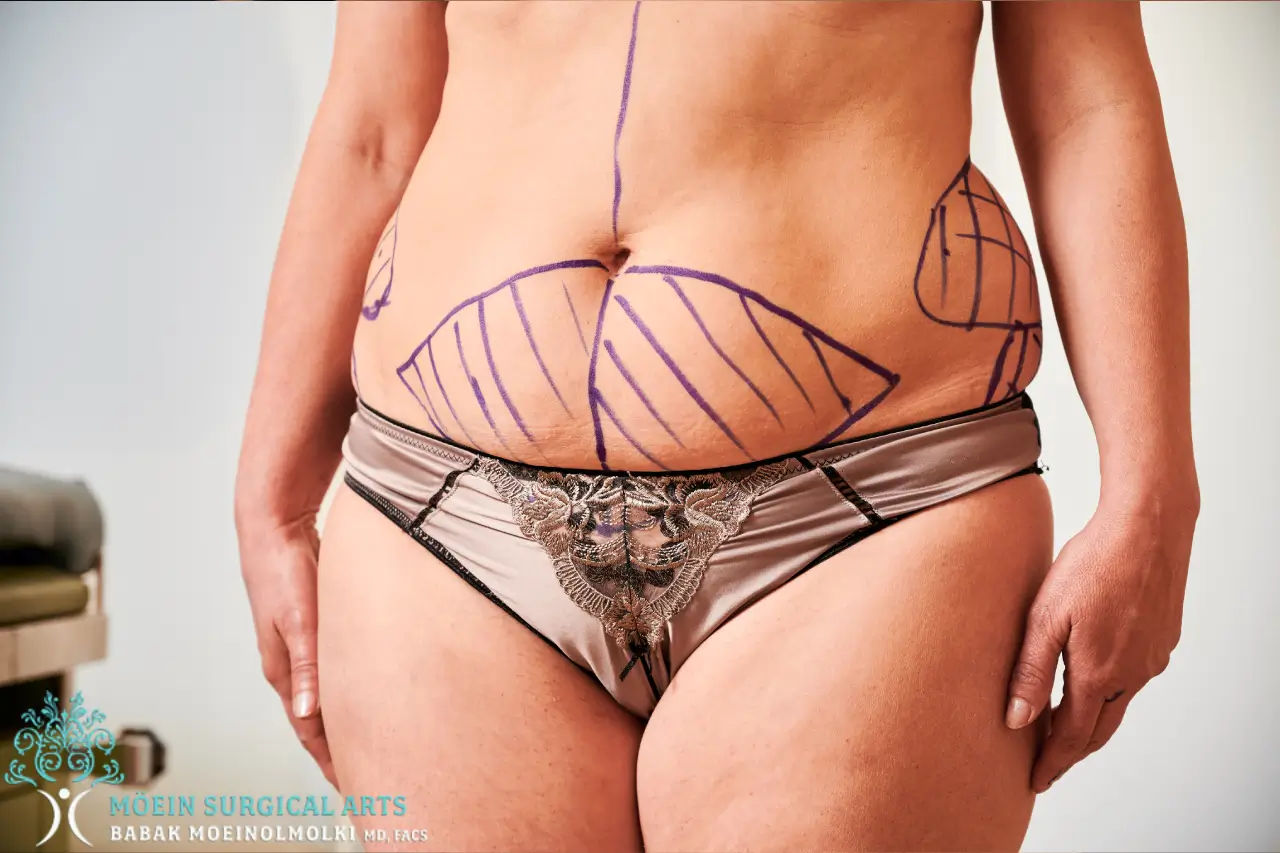
Flank liposuction can help eliminate resistant fat in the waist area and give the abdomen a smoother, more contoured shape. The process involves conducting an examination and procedure plan, administering anesthesia, and marking critical areas that require further sculpting. After applying the fluid, VASER or regular liposuction can help break up fat, allowing sculpting in the flanks.
The small incisions are closed with tiny sutures, and the patient can thereafter wear a compression garment to help support healing and further define the final result. Most patients can return to all activities in several days, with progressive definition to follow.
With the surgical process explained, we can now review several real flank liposuction case examples to show how different techniques and body types respond to treatment.

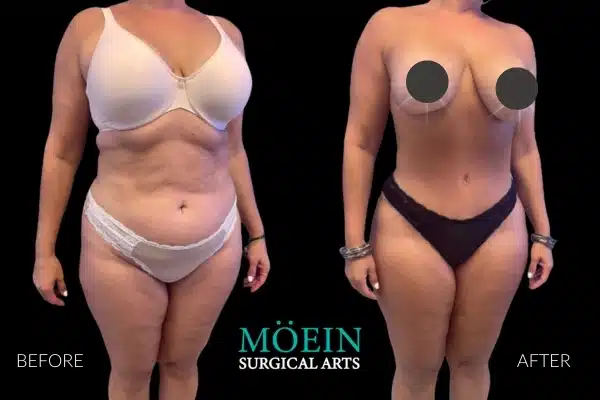
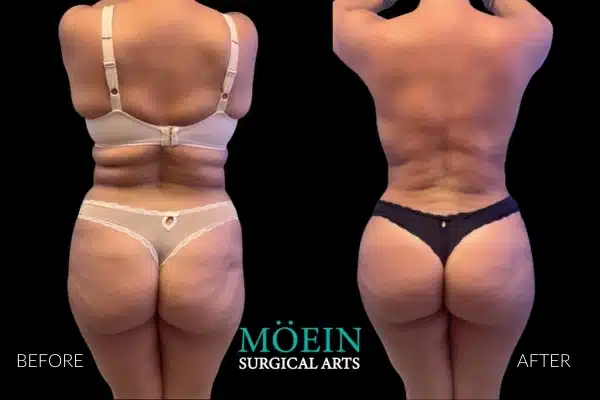
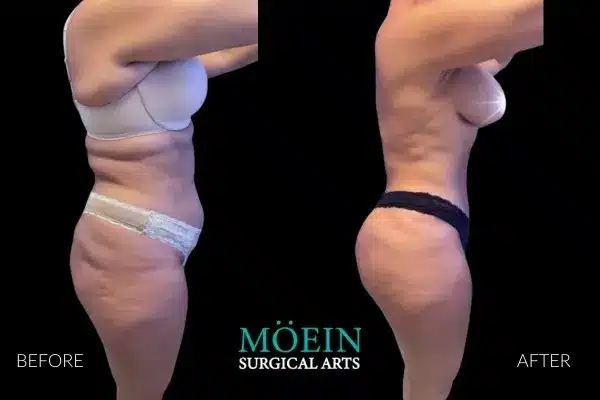
The 49-year-old female patient underwent an Lipo 360 procedure to target the abdomen, flanks, and both upper and lower back to flatten the midsection and further smooth the figure. The patient had hard fat deposits in both the waist and the back.
Using VASER-assisted liposuction, the dense fat in the flanks and back was treated. Standard suction-assisted liposuction was performed in the central and lower abdominal areas to reduce fat. In aggregate, approximately 2.2 to 2.5 liters of fat were aspirated across all treated areas. There was a proportionate distribution of the fat to maintain symmetry.
Also, through the process of defining her lower back and reducing her waistline, her waist-to-hip ratio was enhanced. In fact, her stomach appears flatter and toned in every photo. Evidently, her midsection has toned up, and her back looks smooth with a narrower waist.

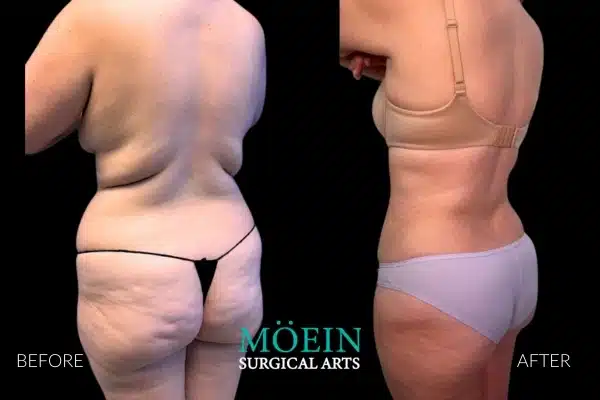
The patient underwent focused liposuction of the flanks and upper and lower back to target the area of fullness around the waistline and bra-line folds. These areas can be very difficult to lose through exercise or diet, and can contribute to an uneven waistline.
Using VASER-assisted liposuction, the fat in the back and sides was emulsified to make it easier to remove while simultaneously facilitating skin retraction. Conventional suction-assisted liposuction was utilized to define the waistline and the junction between the lower back and hip.
In all, about 1.8 to 2.2 liters of fat was estimated to have been shed from the flanks and back. It all translates to a narrower waist, a smoother back, and a more defined midsection, all evident in the after photos.
These advances underscore how focused flank or back liposuction can dramatically alter the waistline without directly treating the abdomen or thighs.

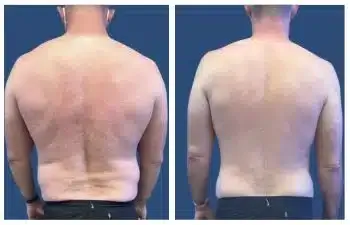
This male patient underwent comprehensive body contouring, including liposuction of the chest, abdomen, flanks, and back, with a focus on improving upper-body definition. A combination of VASER ultrasound-assisted liposuction and traditional liposuction was used to break down dense fat and sculpt the torso more effectively.
A key component of this case was male chest contouring for gynecomastia-like fullness. Excess fatty tissue was removed from the chest to create a flatter, more masculine contour and better definition along the pectoral borders. This approach helps reduce the appearance of chest roundness and enhances overall upper-body proportionality.
Liposuction of the abdomen and flanks helped flatten the midsection and refine the waistline, while fat removal from the upper and lower back smoothed bulges and improved the patient’s profile. Across all treated regions, fat was removed strategically to maintain symmetry and natural muscular highlights.
The after photos show a clearer chest definition, a slimmer waist, and a noticeably more athletic shape from multiple angles — demonstrating how multi-area liposuction can dramatically enhance male torso aesthetics.
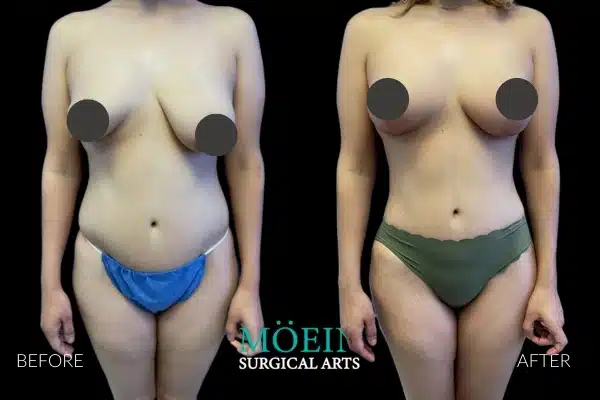
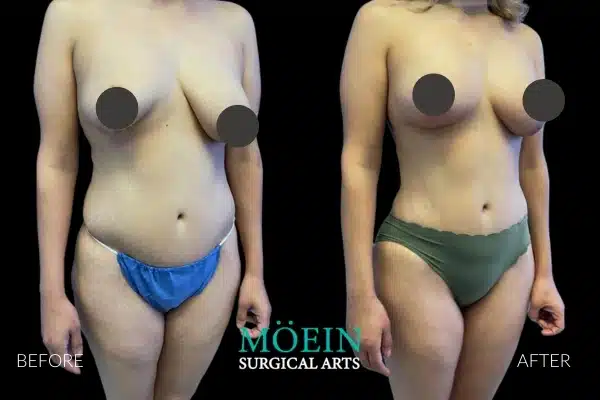
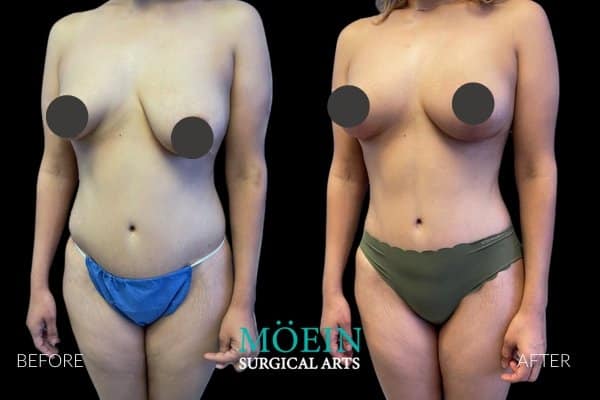
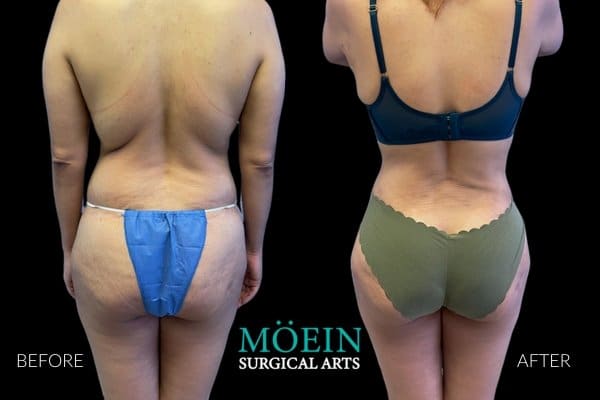
This female patient underwent targeted liposuction of the flanks, waistline, and lower back to address stubborn fat that was blunting her natural curves. These areas are common problem zones that resist diet and exercise, often creating a boxy midsection.
Using VASER-assisted liposuction, Dr. Moein loosened dense fat along the waist and lower back, allowing for smooth extraction and enhanced definition. Traditional suction liposuction was then used to refine the waistline and create a more tapered, feminine silhouette.
Approximately 1.4 to 1.8 liters of fat were removed across the flanks and back. Her after photos show a noticeably slimmer waist, a smoother lower back profile, and improved overall body balance from every angle.

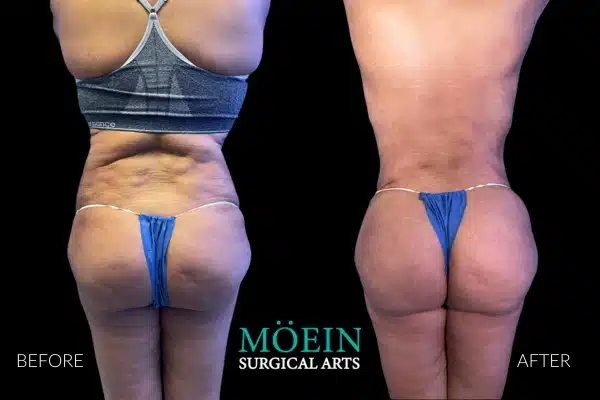
This patient underwent a high-definition Lipo 360 procedure targeting the abdomen, flanks, waistline, and full back to dramatically improve midsection shape. She presented with central abdominal fullness, resistant flank fat, and lower back rolls that created a wider, less-defined torso.
Using VASER-assisted liposuction, qualified Cosmetic Surgeon Dr. Moein emulsified dense fat throughout the abdomen and back, allowing for controlled sculpting and enhanced definition. Additional suction liposuction refined the waistline and highlighted natural abdominal lines without over-carving or creating an artificial look.
A total of approximately 2.5 to 3 liters of fat was removed across the abdomen, flanks, and back. The level of waist reduction and abdominal refinement seen in her results reflects the advantages of individualized, high-definition contouring. Compared with mass-produced approaches such as those used by Sono Bello, this method focuses on artistry, symmetry, and shaping, not just volume removal.
This transformation demonstrates how high-definition Lipo 360 can reshape the abdomen and back simultaneously, delivering a smoother, more youthful silhouette from every angle.
Recovery from liposuction surgery is an essential part of the overall treatment process. The duration of recovery can vary depending on the extent of the procedure and the individual’s healing response. However, most patients can expect a recovery period of two to four weeks. During this time, it is crucial to follow post-operative instructions diligently to ensure optimal healing and minimize complications.
Following liposuction surgery, patients are often recommended to engage in light activities and gradually increase their level of physical activity as tolerated. Strenuous exercises should be avoided for the first few weeks to prevent any undue stress on the surgical site. Gentle walking, on the other hand, is highly encouraged as it promotes blood circulation and reduces the risk of complications such as blood clots.
Another crucial aspect of the recovery process is the use of a compression garment. This garment helps reduce swelling, assist in contouring, and provides support to the treated areas. Patients are advised to wear this garment continuously for the first few weeks after surgery and then as directed by their surgeon.
Walking plays a vital role in minimizing complications after liposuction surgery. It aids in preventing blood clots, stimulating circulation, reducing swelling, and avoiding stiffness. By encouraging patients to walk regularly, surgeons ensure a smoother recovery and help patients regain their mobility more quickly.
In conclusion, the recovery period following liposuction surgery typically lasts two to four weeks. During this time, patients are advised to engage in light activities, continuously wear a compression garment, and walk regularly to minimize complications. Following these guidelines will help ensure a successful recovery from liposuction.
The “Conclusion: Lipo of Flanks Before and After” section is of utmost importance as it serves as a crucial summary of the liposuction results obtained on the patient’s flanks. This section allows the reader to gather a comprehensive understanding of the overall outcomes and transformation achieved through the procedure.
By providing a concise summary of the before and after results, the conclusion highlights the significant changes that occurred in the patient’s flanks. It allows the reader to gauge the effectiveness of the liposuction procedure in addressing the specific concerns related to the flanks. This section plays a pivotal role in depicting the success of the procedure in helping the patient achieve their desired outcome.
Furthermore, the conclusion also serves as a testament to the expertise and skill of the medical professional performing the liposuction. It showcases their ability to sculpt and contour the flanks, resulting in a positive aesthetic transformation. This summary serves as an informative piece for future patients who may be considering the same procedure, allowing them to visualize the potential outcomes and decide if it aligns with their goals.
In conclusion, the “Conclusion: Lipo of Flanks Before and After” section is essential in highlighting the overall outcomes and transformation achieved through the liposuction procedure on the flanks. It provides a concise summary of the before and after results, allowing the reader to gauge the effectiveness of the procedure and appreciate the skill of the medical professional.